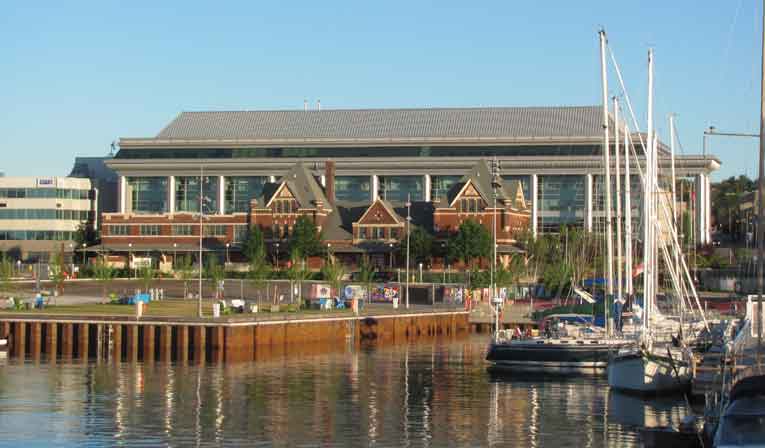Photo Courtesy of Ontario Tourism
Framed by a supine giant and thundering headlands, Lake Superior’s largest city is a contrast of modern amenities and historical gems. From gorgeous blue water to the Blues Festival; Finnish Pancakes to local pickerel; Aboriginal artwork to boreal forests; Thunder Bay embodies the spirit and culture of Northwest Ontario.
Thunder Bay, Ontario, — lovingly referred to as “The Lakehead” and “Canada’s Gateway to the West” — is one of Canada’s greatest outdoor adventure cities. Located on the expansive bay of the same name, the city is an interesting mix of European and Aboriginal cultures, and is the largest city on the largest Great Lake: Lake Superior. My husband, Jerry, and I enjoyed breathtaking and nonstop north shore gunkholing during our circumnavigation of Lake Superior on Monarch, our 52-foot Halvorson raised pilothouse trawler. Now, we looked forward to a taste of civilization at this port of call.
We approached Thunder Bay from our anchorage in Otter Cove at Black Bay Point to the east and knew we were close when we saw the signature landmark, the Sleeping Giant. According to one Chippewa legend, during a time of starvation, Naniboujou — the spirit of deep-sea water — killed his wife during a heated argument. Terrorized by visions of his dead wife, he staggered and fell backward into Lake Superior. The Great Spirit turned him into everlasting stone along the shoreline, where he rests to this day. The contemporary but less romantic explanation is that the formation is an erosion-resistant mesa. Either way, it remains one of the most spectacular headlands on Lake Superior and the highest vertical rise in Ontario at 1,247 feet above lake level.
Further on, we spot the entrance to Thunder Bay, guarded by two massive sentinels: Pie Island and Cape Thunder, another pair of breathtaking headlands on the lake. Aptly named, the Cape’s huge bluffs often create strong, thundering downdrafts. But fear not; the entrance to the Bay is wide and clear with the exception of Hare Island and its reef, which are well marked on the chart.

Photo by Marty Richardson
Annual Events
 Live on the Waterfront
Live on the Waterfront
Wednesday nights all summer long
Folklore Festival
April
Youth Week
May
Movie Nights on the Waterfront
May, August, September, October
Kite Festival
June
Canada Day on the Waterfront
July 1, 2016
Thunder Bay Blues Festival
July 8-10, 2016
Fort William Historical Park Fort Fest
July 15-16, 2016
Festival of Colors
July 23, 2016
Festival of India
July 24, 2016
CLE Family Fair
August 10-14, 2016
Thunder Bay Dragon Boat Race Festival
August 13, 2016
Doors Open Thunder Bay
September 10, 2016
Bay Street Film Festival
September 15-18, 2016
Exploring Our Routes
September 18, 2016
Food Frenzy
October 22
SnowDay
February 20, 2017
Sleeping Giant Loppet
March 4, 2017
Photo Courtesy of Tourism Thunder Bay
Photo by Goh Iromoto/Tourism Thunder Bay
Drop Anchor
Thunder Bay itself has just a few anchorages, including the Welcome Islands, MacKenzie Bay and Amethyst Harbour (the latter two northeast of the city), but some are marginal because of wind exposure from various directions. If the wind is right, check out Sawyer Bay, where you can dinghy in and stretch your legs in Sleeping Giant Provincial Park. On the Sibley Peninsula, the park features more than 50 miles of hiking trails through boreal forests, 200 campsites and inland lakes for canoe and kayak exploration, as well as indescribable views of the Lake Superior coast. It’s definitely worth a day excursion. Take the 2-mile trail to the “chest” of the Giant for a bird’s-eye view of Thunder Bay surrounded by the rugged bluffs of the peninsula, wide open water of Lake Superior, and on a clear day, just a hint of Isle Royale in the southern distance.
Even if you decide to anchor in the bay, you simply must get up close and personal with the city itself. Just clear the small group of Welcome Islands, which lie about 5 miles south of the city, and look for the iconic, high-water Thunder Bay Main Lighthouse marking the entrance to Thunder Bay’s inner harbor. Once there, three entrances punctuate a 4.5-mile-long breakwall (with the middle entrance most often used by recreational boaters). Stay in the marked channel to avoid any shoaling.
Within the harbor lies Prince Arthur’s Landing at Marina Park: 35 acres of waterfront and parkland with three main piers, 271 slips with water, 30- and 50-amp hookups, walkways and picnic areas, fuel and pump-out, restrooms, showers, laundry, 24-hour security, and a common area where you may clear customs if you are just entering Canadian water. We docked Monarch at the transient dock alongside Pier 3.
Another facility for boaters is the Thunder Bay Yacht Club, several miles to the south along the Mission River. We contacted them, hoping to view the facility while in town, and a very friendly member and dock chairman, Richard Matheson, not only welcomed us warmly but also picked us up for the 15-minute drive to the facility. This hospitable club has a visitor’s dock with slips for small boats and offers reciprocity to visiting yacht club members; however, it is a bit removed from shopping and restaurants.
Discover downtown
In downtown Thunder Bay, the focal point of the waterfront is the beautifully restored, Chateauesque Canadian National (CN) Railway station, which provides a historical contrast to the ultra-modern, glass Office of the Registrar across Water Street. Thunder Bay’s maritime center has a rich history of fur trapping and trading, silver mining and grain transshipment — aided by the opening of the Soo Locks in 1855 and the completion of the Canadian Pacific Railway to the western prairies. Even today, this port boasts the largest grain elevator and grain-shipping complex in the world, and is a center for production of paper and other pulp products.
Just across the tracks from the station, Marina Park features a splash pad designed for cooling off; on the warm days we spent in town, scores of kids of all ages frolicked in its spray. The park is home to a large display of public art, including “Traveller’s Return” — stylized, giant aluminum water droplets with a reflective, mirrored finish. Another work of art is the “Jiigew” (meaning “by the water” in Ojibwe), a pair of bent I-beams, each 65 feet high, installed with rows of cascading LED lights. At night, they impart inspirational messages for those who know Morse Code. On Pier 2, three elevated cedar lanterns (Paleogirls, Swimmers and Ulysses) feature colorful artwork depicting man’s relationship to water and nature. Written art is featured in a dozen locations throughout the park, providing an opportunity to pause and reflect on the spirit and culture of Northwest Ontario. For indoor art, try the public Thunder Bay Art Gallery with its permanent collection of more than 1,500 Aboriginal works, or the fine, private and cooperative galleries. Baggage Building Art Centre, located in a renovated, historic freight shed at Marina Park, showcases work by local artists and offers workshops for aspiring artists of all ages.
As the city’s main event and festival location, Marina Park is center stage for Canada Day celebrations, the summer-long, Wednesday night Live on the Waterfront concert series and Thunder Bay’s Annual Blues Festival held in July. When we visited, a five-piece band of seasoned blues musicians called the Bluesbangers entertained us. Late July heralds the Thunder Bay Dragon Boat Festival — a feast for the eyes and for competitive spirits. For some time on the links, try one of the two city-operated public golf courses — Chapples Golf Course and Strathcona Golf Course — or several privately owned courses.

Photo Courtesy of Ontario Tourism
Tour Thunder Bay
The city’s rich history is on display in a variety of self-guided walking tours. My favorite is the Thunder Bay North tour, as it begins and ends adjacent to the docks at Marina Park and is concentrated in the commercial area that was formerly downtown Port Arthur. Taking less than an hour, the tour includes 23 of the most historical and architecturally significant buildings the area has to offer, including Prince Arthur Hotel, Ottawa House, Trinity United Church and Masonic Hall. Be sure to visit the Thunder Bay Historical Museum to pick up a tour brochure.
Sports fans and history buffs alike should also stop at the nearby Northwestern Ontario Sports Hall of Fame and Museum.
The city’s efficient transit system is a good way to explore even farther, so you can visit the Fort William Historical Park on the Kaministiquia (Kam) River a few miles from the waterfront. The park is a meticulous recreation of the 19th century original, with 57 heritage and modern buildings on 250 acres. One of the more interesting structures within the fort is the canoe shed, where you can view — in various stages of construction — the oversize canoes that long ago plied the Great Lakes.
Revel in the spectacular Northwest Ontario nature while hiking Silver Falls, one of the classic Thunder Bay hiking trails also along the Kam River, with plenty of lookouts over Lake Superior. Want to get your hands dirty? Amethysts are the official gemstone of Ontario — even the local 9-foot-tall Terry Fox monument has a foundation made out of Thunder Bay amethyst — and you can try your hand at finding your very own gem at the Amethyst Mine Panorama. As the largest deposit in Canada, you can take a guided or self-guided tour to “dig your own” stone. There are other open-pit mines in Thunder Bay, including Blue Point Amethyst Mine and Bill’s Old Amethyst Mine.
Thunder Bay has plenty of opportunities for urban fishing, or “the fancy name for fishing in the city,” says Thunder Bay angler and journalist Gord Ellis. “Thunder Bay is unique because it has both cold and warm water species… All of them are available within the city.”
Cast a line in the Kam River and Current River — both excellent spots for urban fishing. “I learned to fish the streams within the city and the fishing has remained quite good,” Ellis says. “If you’ have any interest in fishing, Thunder Bay is a good place to come.”
Spend the afternoon touring vibrant and exotic plants at the Centennial Botanical Conservatory. Built in 1967 as a Centennial project, the Conservatory offers a year-round escape to view lush plants and flowers from around the world, waterfalls and wishing ponds.
A historic centerpiece of downtown Thunder Bay is the Pagoda, the oldest operating tourist bureau in Canada. The unusual far-eastern style building, dating back to 1909, still provides travel information to Thunder Bay area tourists. The Ontario Heritage Site’s knowledgeable staff provided us with literature to area attractions and local dining recommendations, resulting in a fine pickerel dinner with “the best buns in town” at the Prospector Steak House, one of Thunder Bay’s top ten restaurants.
Local tastes
Speaking of fine dining, there are enticing gastronomic options for every taste in more than 200 restaurants in town; more than 40 of those are within walking distance of Prince Arthur’s Landing Marina. A perennial favorite is the Caribou Restaurant + Wine Bar, which helps you explore local flavor, featured Ontario VQA wines and the chef’s personal take on a Canadian staple, poutine: Shoestring frites, thunder oak cheese curds and braised short rib gravy.
One of Thunder Bay’s culinary highlights is Uptown Cut, a Canadian steakhouse with a modern twist. The owner focuses on sustainable artisanal foods and supporting the local beef industry. The New York Times’ Sunday, January 17, 2016 issue provided a rave review of this establishment, including kudos to the foie gras croquette and wagyu beef, which the reviewer reported, “was the best steak of my life.”
Located inside the CN Station, the Breakwater Taphouse is “a hidden gem with hard-to-find beer,” according to Thunder Bay’s The Walleye magazine. Nearby, the waterfront Bight Restaurant & Bar offers a farm-to-table menu paired with an eclectic wine and cocktail list.
In keeping with Canada’s diverse taste in cuisine, the Masala Grille provides a unique Indian and Thai experience at a reasonable price. Try the curry cauliflower soup for starters. At The Silver Birch Restaurant, start with the wild mushroom tart, followed by a main course of tarragon rabbit, accompanied by homemade bread with blueberry infused oil. Finnish cuisine and culture is reflected at both The Hoito (housed in the historic Finnish Labour Temple) and the Scandinavian Home Restaurant. No matter what time of day, try the Finnish pancakes.
Jumping off point
Before you leave “The Lakehead,” swing by Sail Superior.com Yacht Charters on Pier 3 for a 90-minute harbor cruise, a 3.5-hour Welcome Island excursion or a variety of other private cruises, including the Twilight Wine and Cheese cruise.
To hunt for the “catch of the day,” hop on Archie Hoogsteen’s boat, the owner of Archie’s Fishing Charter’s, also located at Prince Arthur Landing’s Marina. You only need to bring aboard a cooler, a fishing license and comfortable shoes.
As you head out of Thunder Bay, consider stopping at Thompson Island. Area cruisers have adopted the island just south of Pie Island and constructed a free 240-foot dock and boardwalk in Wray Bay. The narrow entrance is roughly two-thirds of a mile from the island’s northeastern tip, and dockside soundings vary from 2 to 9 feet at the far western end of the boardwalk. With amenities — including a barbecue area, rustic benches and a fire pit — weekends can get crowded here; if the docks are full, rafting is expected. It’s definitely worth it to partake in the steaming sauna, followed by a plunge from the dock into frigid Lake Superior. If you want to use the fire pit or sauna, bring your own wood; over the years, the island’s deadwood has been depleted. Island hiking trails — complete with rope assists, tree ladders and a rope bridge — offer many spectacular views. The island also features a number of mysterious circular pits known as Pukaskwa Pits, allegedly built by prehistoric natives or even historic voyageurs. This idyllic spot makes a convenient jumping off point if, like Monarch, you are headed for another of Lake Superior’s gems, Isle Royale.
Whatever piques your interest for adventure or relaxation, come take advantage of the northern hospitality and scenic beauty that is Thunder Bay.
About the Author
In nine years of cruising, Marty and Jerry Richardson have logged more than 30,000 nautical miles while cruising the Great Lakes, Georgian Bay, Trent-Severn, New York Canals system and Finger Lakes, middle U.S. river systems, Hudson River, Atlantic and Gulf coasts, Florida Keys and Bahamas, including two Great Loops.
Cruising Guide
 When cruising anywhere in Lake Superior, make sure you have the definitive Cruising Guide to Lake Superior: Bonnie Dahl’s Superior Way, published by Lake Superior Port Cities lakesuperior.com. This little gem has amazing and accurate first-person insights, commentary and detailed schematics of anchorages, ports and passages. Its comprehensiveness is unparalleled.
When cruising anywhere in Lake Superior, make sure you have the definitive Cruising Guide to Lake Superior: Bonnie Dahl’s Superior Way, published by Lake Superior Port Cities lakesuperior.com. This little gem has amazing and accurate first-person insights, commentary and detailed schematics of anchorages, ports and passages. Its comprehensiveness is unparalleled.
Photo Courtesy LakeSuperior.com


